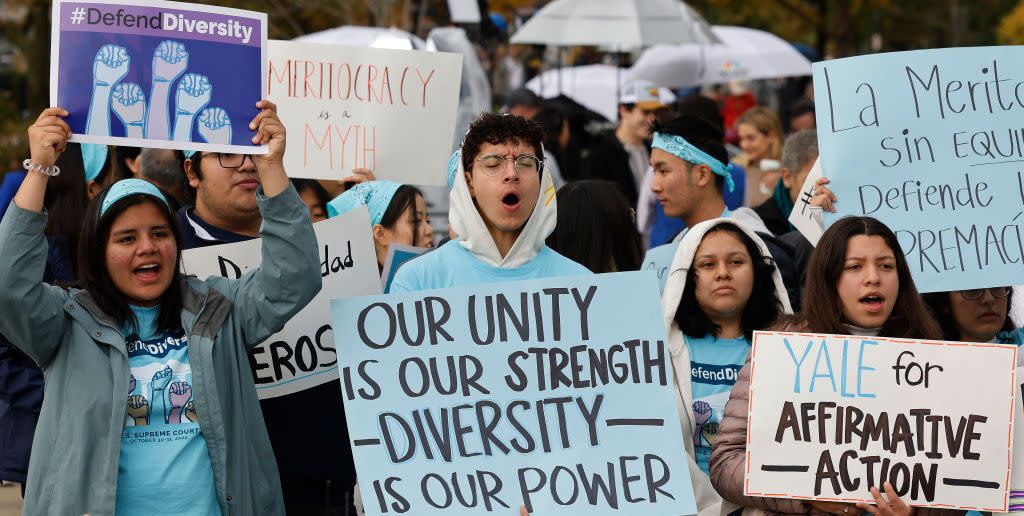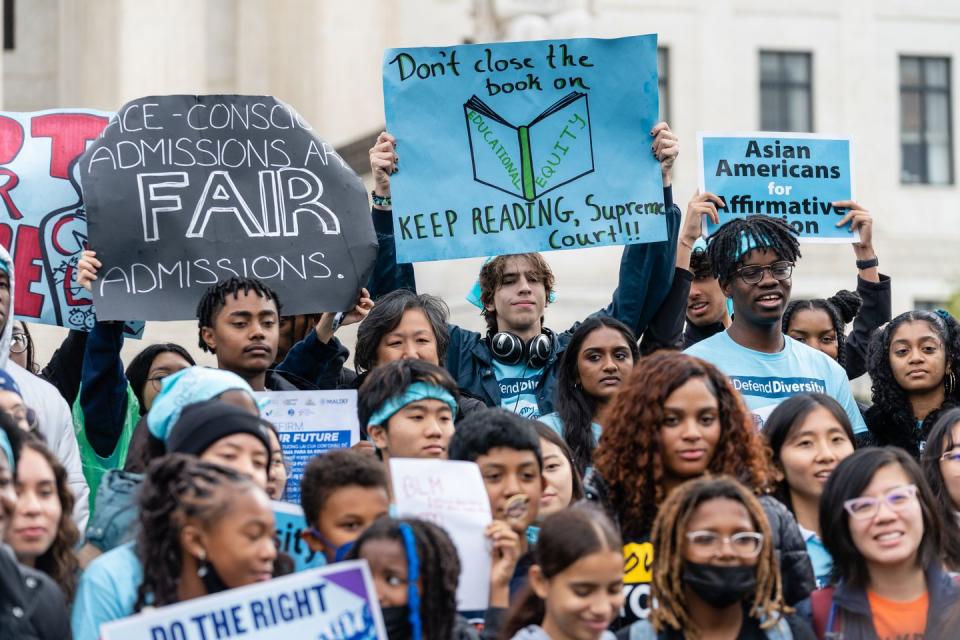What to Know About the Supreme Court Overturning College Affirmative Action

- Oops!Something went wrong.Please try again later.
- Oops!Something went wrong.Please try again later.
- Oops!Something went wrong.Please try again later.
- Oops!Something went wrong.Please try again later.
- Oops!Something went wrong.Please try again later.
On June 29, 2023, the United States Supreme Court ruled that colleges and universities can no longer take race into consideration when granting admission offers. This landmark decision states that affirmation action violates the equal protection clause of the Constitution.
In a divided ruling, the court's six conservative judges found that admissions policies at Harvard and the University of North Carolina discriminated against white and Asian American applicants by using policies that benefited applicants from underrepresented races.
Chief Justice Roberts wrote the opinion by the conservative majority stating: "Both programs lack sufficiently focused and measurable objectives warranting the use of race, unavoidably employ race in a negative manner, involve racial stereotyping, and lack meaningful endpoints. We have never permitted admissions programs to work in that way, and we will not do so today."
The ruling will not apply military service academies.
Justice Samuel Alito, Justice Brett Kavanaugh, Justice Neil Gorsuch, and Justice Amy Coney Barrett joined Chief Justice John Roberts in ruling to overturn affirmative action. The three liberal Justices—Justice Stephen Breyer, Justice Sonia Sotomayor, and Justice Elena Kagan—dissented.
This ruling goes against more than 40 years of legal precedent. Affirmative Action has been supported in America since the Bakke decision in 1978 which stated that consideration of race in college admissions was legal. It was also supported in the 2003 Grutter v, Bollinger ruling that said race could be considered in the admission process because universities had a "compelling interest" in having diverse populations on campus.

The court's three liberal judges that dissented said the decision “rolls back decades of precedent and momentous progress."
“The devastating impact of this decision cannot be overstated,” Justice Sotomayor said.
The ruling represents an ideological divide between the court and the country. Currently, over two-thirds of Americans under thirty years old have unfavorable views of the Supreme Court according to a survey by Pew Research.
Here, we break down further details about the Supreme Court’s ruling to overturn affirmative action policies, provide several ways to protest safely, and share what this ruling means for current and future college students.
What is Affirmative Action?
Prior to the ruling, affirmative action policies meant that university admissions officers were allowed to consider a student's race in addition to their grades and extracurricular activities when reviewing college admissions applications. The goal of these policies was to help ensure that everyone receives equal access to educational opportunities. Affirmative action is rooted in the idea that America is not colorblind and that some racial demographics still receive fewer opportunities than others. Affirmative action is used to combat this and is a tool that universities and colleges have used to promote diversity within their institutions.
What Does it Mean to "Overturn" Affirmative Action?
Both the Harvard and University of Chapel Hill affirmative action cases were brought by conservative activist Edward Blum. Now that the ruling has passed, schools will likely be forced to reshape their admission practices. This ruling means that admission teams won't be able to consider race at all when accepting students.
Among the dozens of institutions with admissions policies that currently take race into account are Yale University, Brown University, Columbia University, the University of Pennsylvania, the University of Chicago, and Dartmouth College. According to AP News, all but one of the U.S. colleges and universities the nine justices attended urged the court to preserve race-conscious admission policies.
Allowing colleges and universities to consider race as one of the multiple factors in the admissions process "has helped equalize educational opportunities for all students of every race and background and has improved racial diversity on college campuses," Justice Sotomayor wrote in her dissent statement. "Although progress has been slow and imperfect, race-conscious college admissions policies have advanced the Constitution’s guarantee of equality."
How Does an Affirmative Action Ban Impact Admission?
Right now, it's not completely clear how the ruling will effect each institution's admission policies. What we do know is that a study in the Journal of Public Economics found that past state-level bans of affirmative action affected enrollment of underrepresented communities negatively. A study done by the Educational Evaluation and Policy Analysis Journal found that students of color will experience a 23 percentage point decline in admission to highly selective public colleges across the country after affirmative action is banned.
Basically, while it will vary from school to school, but past data shows that affirmative action bans decrease diversity in universities.
Former First Lady Michelle Obama weighed in on the ruling in an Instagram post: "It wasn’t perfect, but there’s no doubt that it helped offer new ladders of opportunity for those who, throughout our history, have too often been denied a chance to show how fast they can climb," she said.
Former President Barack Obama echoed his wife's statement on his official social media platforms, saying that affirmative action “allowed generations of students like Michelle and me to prove we belonged. Now it’s up to all of us to give young people the opportunities they deserve — and help students everywhere benefit from new perspectives.”
I 'm a Student. What Does This Mean for Me?
Colleges and universities are still encouraged to maintain diversity at their institutions. As a student this means that the admission policies will likely vary from school to school.
Students should know that President Joe Biden is also encouraging universities to consider diversity in other ways. President Biden said in an official statement released by the White House shortly after the ruling that he disagreed with the court and urged colleges to seek to increase diversity in other ways instead of letting the ruling “be the last word.”
Students concerned about diversity at their schools should also be aware the Biden administration also announced several plans to help colleges continue their recruitment and admit a diverse student body. The administration says they plan to release a report on strategies for increasing diversity and to provide schools with guidance in light of the ruling. Students can hold their university accountable by staying involved in student government and up to date with new policy changes. According to Stanford University, creating a culture of accountability can be one of the best ways to stand up to institutions.
In fact, presidents of many colleges like Harvard and the University of North Carolina at Chapel Hill have already issued statements about their commitment to diversity regardless of the court's ruling. They said they would follow federal law and are still assessing how the ruling affects their institutions. Students are encouraged to learn what their own universities say on the matter.
We also want to acknowledge that this ruling can be very upsetting. It feels like a number of social justice issues have been challenged in the last few years. You are not alone in these feelings. Even President Biden referenced the court's overturn of Roe v. Wade in 2022 in his White House statement: "Take a look at how it's ruled on a number of issues that have been precedent for 50-60 years sometimes," he said. "That's what I meant by not normal."
Putting yourself and mental health first is important. If you are feeling overwhelmed by this ruling, we recommend reaching out to someone to talk about it with. This can be a therapist or one of these options if therapy is not feasible for you right now.
Can High School Senior Students of Color Still Apply to Competitive Schools?
100 percent. Yes. In fact, it is encouraged. You should absolutely apply to whatever school you feel is a best fit for you.
Students of color can still talk about their racial and ethnic background in personal statements and essays when applying to a university. While the ruling says a college or university can’t use race as an admittance factor, it says nothing about students talking about how their racial or ethnic identity has shaped their personal lives.
Per Biden's White House statement given shortly after the ruling, universities are actually encouraged to consider other adversity that student have overcome. This can include socioeconomic status, location, high school ranking, personal experiences of hardship, and racial discrimination. Colleges are also allowed to consider whether a student speaks multiple languages or if they are the first in their family to attend college.
This is because, as Justice Sotomayor points out in her statement, “Those factors are not ‘interchangeable’ with race.”
We recommend working with a college counselor if you're able or looking online to see what schools educational programs and social environmental feel they could work for you. It's important to still put your best foot forward on applications. The ruling might affect how admission policies work, but it doesn't change the work you have done to get where you are.
What Can I Do in Light of the Ruling?
Right now, the most important thing students and young people can do is support institutions and programs that support diversity in higher education. In a statement released shortly after the ruling on Medium, former President Obama explained that this support is instrumental. "In the wake of the Supreme Court’s recent decision, it’s time to redouble our efforts," he said.
He provided a list of organizations he recommends getting involved with that work to support diversity at universities and colleges. While donating is the most common way in for people looking to get involved in the organizations listed below, we've listed ways to help that do not involve money since not everyone is able to contribute financially.
Students can reach out to local offices and branches to volunteer.
Students can volunteer as scholarship essay readers. This is a great way to donate time to ensuring that deserving students receive aid. Students can also become mentors or volunteer at scholar conferences.
Students can become a mentor to younger peers and be scholarship essay readers.
Young people can spread the word using social media.
Students can stay informed via email newsletters, join the national selection committee and read and score applicant essays, and share their voice by submitting their own stories.
Thurgood Marshall College Fund
Students can utilize their advocacy toolkit to work with politicians to enact change.
Students can see if their school has a partner program with DC CAP.
Students can fundraise using their toolkit and sign up to volunteer at local events.
What About Protesting?
Many students have found that peacefully protesting can draw attention to their concerns. Keeping an eye out on social media can be a good way to find protests. Social media accounts will often post the dates, times, as well as any additional information. While there are no nationally organized affirmative action protests yet, protesting on a smaller scale can also be effective. We recommend these tips when protesting to stay safe.
And of course. Vote! We know you hear this all the time, but your vote is what shapes the nation. Putting politicians in power that will fight for you is the most important thing you can do.
You Might Also Like

